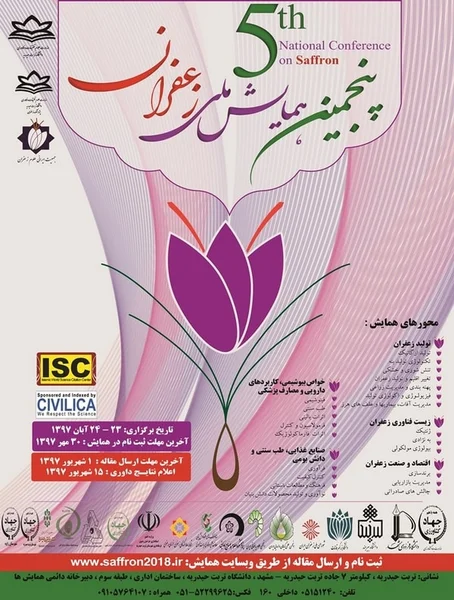-
evaluation of saffron yield changes in response to temperature and rainfall variations in birjand
جزئیات بیشتر مقاله- تاریخ ارائه: 1397/07/30
- تاریخ انتشار در تی پی بین: 1397/07/30
- تعداد بازدید: 412
- تعداد پرسش و پاسخ ها: 0
- شماره تماس دبیرخانه رویداد: -
climate change is one of the most important factors in changing the distribution area and reducing saffron yield over the past two decades. in this study the effect of rainfall and temperature was studied on saffron yield changes in birjand, during 2004-2016. the recorded temperatures were compared with the temperature thresholds for cold stress during winter (~- 15oc), optimal temperature for flower initiation in mid-summer (~25°c) and the optimum temperature for flower appearance in mid-autumn (~15°c). results showed that the main cold stress during the experimental period occurred in winter 2008, where the mean air temperature and the lowest recorded temperature in january were -2 and -19.6°c, respectively. the outcome of this occurrence was a considerable decline in stigma yield in the next two years (2009-2010), which was 2 times lower than 9 other years (3.83 vs 1.9 kg ha-1). the mean air temperatures for flower initiation during august, in the experimental period were between 24.5-29.9°c, while the maximum temperatures were between 34.8-41.8°c, which aren’t suitable for the process of flower formation. similarly, the temperature in november for flower appearance was not appropriate, so that, mean, minimum and maximum air temperatures in this month during study period were between 8.8-12.3°c, -2.4 to -11.5°c and 23.1-28.2°c, respectively. the rainfall trend also revealed a decline in december and january, in the last years compared to the early years of the past decade. overall, it seems that change in climatic parameters is a main reason for high gap yield in saffron cultivation.
حوزه های تحت پوشش رویداد
مقالات جدیدترین رویدادها
-
استفاده از تحلیل اهمیت-عملکرد در ارائه الگوی مدیریت خلاقیت سازمانی و ارائه راهکار جهت بهبود
-
بررسی تاثیر ارزش وجوه نقد مازاد بر ساختار سرمایه شرکت های پذیرفته شده در بورس اوراق بهادار تهران
-
بررسی تأثیر سطح افشای ریسک بر قرارداد بدهی شرکت های پذیرفته شده در بورس اوراق بهادار تهران
-
بررسی تأثیر رتبه بندی اعتباری مبتنی بر مدل امتیاز بازار نوظهور بر نقد شوندگی سهام با تأکید بر خصوصی سازی شرکت ها
-
تأثیر آمیخته بازاریابی پوشاک ایرانی بر تصویر ذهنی مشتری پوشاک ایرانی (هاکوپیان)
-
چگونه توانستم مانع ترک تحصیل دانش آموزم سعید (کودک کار) شوم؟
-
ارائه مدلی جامع جهت شناسایی عوامل موثر بر انتخاب برند اینترنتی
-
تحلیل روند صادرات و بسته بندی در ارزآوری زعفران
-
نقش بازارهای سنتی در هویت بخشی به شهر ایرانی اسلامی (مطالعه موردی بازار قیصریه اصفهان)
-
taking a look behind the wheel: an investigation into the personality predictors of aggressive driving
مقالات جدیدترین ژورنال ها
-
مدیریت و بررسی افسردگی دانش آموزان دختر مقطع متوسطه دوم در دروان کرونا در شهرستان دزفول
-
مدیریت و بررسی خرد سیاسی در اندیشه ی فردوسی در ادب ایران
-
واکاوی و مدیریت توصیفی قلمدان(جاکلیدی)ضریح در موزه آستان قدس رضوی
-
بررسی تاثیر خلاقیت، دانش و انگیزه کارکنان بر پیشنهادات نوآورانه کارکنان ( مورد مطالعه: هتل های 3 و 4 ستاره استان کرمان)
-
بررسی تاثیر کیفیت سیستم های اطلاعاتی بر تصمیم گیری موفق در شرکتهای تولیدی استان اصفهان (مورد مطالعه: مدیران شرکتهای تولیدی استان اصفهان)
-
نقش شخصیت در تعهد و سلامت سازمانی پرستاران شاغل در بیمارستان های شهر اراک
-
درآمدی بر اهمیت فرآورده ها و مشتقات محصولی میوه انار برای مدیریت مسائل انسانی
-
بررسی تاثیر هزینه نمایندگی بر بیش سرمایه گذاری
-
بررسی تأثیر مالکیت دولتی و خصوصی بر حاکمیت شرکتی(مورد مطالعه: شرکت مخابرات ایران-واحد زاهدان)
-
application of anp network analysis process method in swot model




سوال خود را در مورد این مقاله مطرح نمایید :